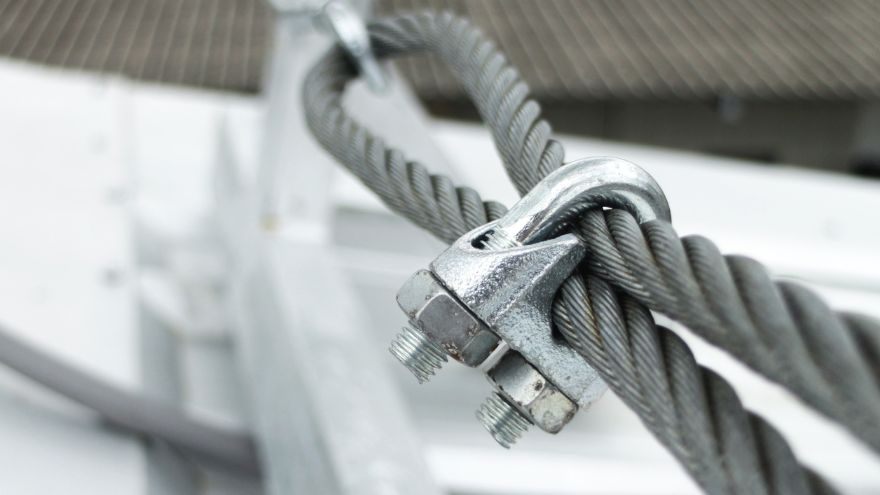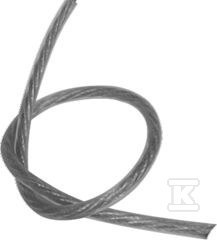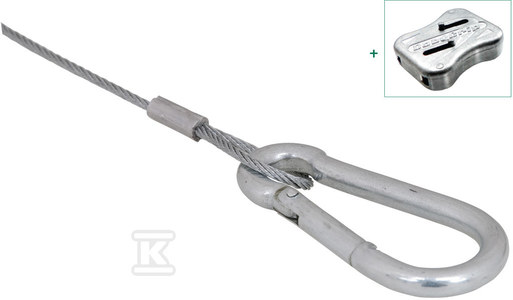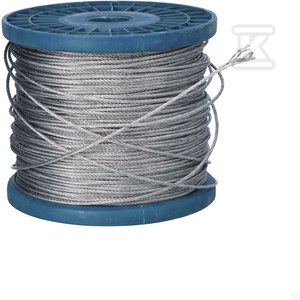Steel ropes, made of ordinary or galvanized steel, are used in many industries: from construction, through electrical engineering, to transport. They are suitable for various types of work - professional and amateur. They are an integral element of a zip line, winch or metal cable route. Stainless steel cables are characterized by very high resistance to corrosion, mechanical damage, stretching, abrasion and crushing. The steel rope can be safely loaded statically and dynamically. It is not threatened by the most difficult weather conditions. Extremely high durability often goes hand in hand with structural flexibility. Find out which steel cable will be suitable for the planned application and how to properly select snap hooks for the cables.

Check out carabiners at the Onninen wholesaler
Selection of the thickness of the steel cable to the load
Steel ropes available on the market have different parameters. The key feature of every steel rope is its breaking force, or breaking resistance. The decisive factors here are: the diameter of the rope and the strength of the wires used in the production process. When safety is a priority, it is worth, and sometimes even necessary, to calculate the permissible load of a given structure (in tons) and the optimal diameter, using a ready-made formula:
Safe load = breaking force [kN] x 0.10197 / safety factor (usually defined by regulations)
 When selecting the diameter and construction of a steel rope, it is taken into account, among other things, whether the rope runs on a drum or pulleys. If so, the appropriate ratios should be maintained: the diameter of the drum or pulley to the diameter of the rope and the diameter of the drum or pulley to the diameter of the wire. If the steel rope is to be used in conditions of increased risk of abrasion and corrosion, the diameters of the outer layer wires should be as thick as possible.
When selecting the diameter and construction of a steel rope, it is taken into account, among other things, whether the rope runs on a drum or pulleys. If so, the appropriate ratios should be maintained: the diameter of the drum or pulley to the diameter of the rope and the diameter of the drum or pulley to the diameter of the wire. If the steel rope is to be used in conditions of increased risk of abrasion and corrosion, the diameters of the outer layer wires should be as thick as possible.
In addition to the diameter itself, the parameters of steel ropes such as their flexibility, resistance to rotation and crushing, and grease protection are also important for the efficiency, durability and safety of work.
Please remember that a structure made of thick wires will be relatively stiff. This is the right solution provided you want a little flexibility. However, lines made of thin wires will, on the one hand, be more flexible, but on the other hand, more sensitive to transverse pressures and deformations. They will be damaged more quickly if they are rubbed against the pulleys.
What size should a steel cable carabiner be?
 The connecting element at the end of the steel cable is a carabiner (also known as a carabiner). It is small in size and has a characteristic shape of a metal ring with an opening lock on one side. It is used for quick and reliable connection of elements and mobile mounting. An optional lock prevents accidental opening. People unrelated to the electrical engineering, construction or transport industries will associate carabiners primarily with climbing equipment.
The connecting element at the end of the steel cable is a carabiner (also known as a carabiner). It is small in size and has a characteristic shape of a metal ring with an opening lock on one side. It is used for quick and reliable connection of elements and mobile mounting. An optional lock prevents accidental opening. People unrelated to the electrical engineering, construction or transport industries will associate carabiners primarily with climbing equipment.
When choosing a snap hook for a steel cable, you should pay attention to the material from which it is made, its purpose and the method of installation. For each carabiner you can find information about which steel cables (i.e. what maximum diameter) a given model is suitable for.
Snap hooks and steel cables at the Onninen wholesaler
 At the Onninen wholesaler you will find the highest quality, corrosion-resistant steel cables, snap hooks and lines integrated with snap hooks. All products meet rigorous safety standards. We are an electrical engineering wholesaler, so we specialize in the sale of steel cables and carabiners for creating cable routes and suspending lamps and trays. We offer individual products and entire metal supporting cable systems.
At the Onninen wholesaler you will find the highest quality, corrosion-resistant steel cables, snap hooks and lines integrated with snap hooks. All products meet rigorous safety standards. We are an electrical engineering wholesaler, so we specialize in the sale of steel cables and carabiners for creating cable routes and suspending lamps and trays. We offer individual products and entire metal supporting cable systems.
You don't know which steel cable will provide the desired strength? Are you wondering whether a three-layer or four-layer design would be better for a given application? Or maybe you have trouble choosing a carabiner? Contact Onninen's technical team. We will answer your questions and advise you.